FGNA Canadian Region P2P Sunday, September 24, 2023 ~ Transformation of Trainings (ToT)
~ Presentation and discussion with Violet Van Hees, Jaclyn Boone, Tracy Mulligan, and Katarina Halm,
~ Noting much appreciation also to Bonnie Humiston!
Description & Zoom ~ ToT Sept 24, 2023
* Link to the description, which includes a link to the registration.
https://docs.google.com/document/d/14q6HjeqBVikMHr4992tYXgbvUhs8e7PXsxmV9ehCymI/edit
* The (zoom) registration link: https://us06web.zoom.us/meeting/register/tZAsceqgrz0sHt37yPvUssDCMp9NrD7id0id
| Oliver Reimer: Taiji Chicken or Feldenkrais Egg? |
The recent Canadian Region P2P on Sunday, May 28, 2023 ‘Polyvagal Theory in Practice’
Please see below for slides, notes and links!
Sunday, May 28, 2023, FGNA Canadian Region P2P Presentation (PolyVagal Theory)
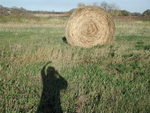
DESCRIPTION:
Inspired by PolyVagal Theory (Stephen W. Porges) and Lessons on Self-Image (Moshé Feldenkrais), the May 2023 P2P Presentation will follow in the footsteps of a previous Canadian Region Webinar ‘Fight/Flight and Freeze’ a helpful perspective from Violet van Hees 2019.
SHORT INTRODUCTORY CLIP
Rob Black, Chair of the Canadian Region of Feldenkrais® Practitioners,
speaks with Katarina Halm about the upcoming seminar: please CLICK
RECORDING AND RESOURCES
For those who register, Rob Black will provide a recording and resources after the seminar.
PIVOTAL QUOTES:
We act in accordance with our self-image. This self-image—which, in turn, governs our every act—is conditioned in varying degrees by three factors: heritage, education, and self-education.”
–– Moshé Feldenkrais, Preface to Awareness through Movement. 1972, 1977
“In those moments when awareness succeeds in being at one with feeling, senses, movement, and thought, the carriage will speed along on the right road. Then man can make discoveries, invent, create, innovate, and know He grasps that his small world and the great world around are but one and that in this unity he is no longer alone.”
–– Moshé Feldenkrais , page 54 Awareness through Movement. 1972, 1977
“‘the fittest may also be the gentlest, because survival often requires mutual help and cooperation’ (Dobzhansky, 1962). According to Dobzhansky, it is this capacity to cooperate that enabled the earliest mammalian species to survive in a hostile world dominated by physically larger and potentially aggressive reptiles. Although unaware of Dobzhansky’s major contributions, the publication that introduced Polyvagal Theory was titled “Orienting in a defensive world: Mammalian modifications of our evolutionary heritage. A Polyvagal Theory” (Porges, 1995). In retrospect, the title was a tribute to Dobzhansky’s insightful statement that “nothing in biology makes sense except in the light of evolution” (Dobzhansky, 1973).” –– Stephen W. Porges, page 135 in Porges, S. W. (2020). The COVID-19 Pandemic is a paradoxical challenge to our nervous system a Polyvagal Perspective. Clinical Neuropsychiatry, 17(2),135-138.
REFERENCES
ATM Book Feldenkrais, M. (1972). Awareness Through Movement: Health Exercises for Personal Growth / Moshé Feldenkrais. New York, NY: HarperCollins.
Lesson 8 Perfecting the Self-Image 130
“Each time, observe the parts of your body that are missing in the body image of the movement and try to complete the image.”
Lesson 8 Perfecting the Self-Image 130
Action without awareness
Raising of the foot while lying on back
Head movement in an arc close to the floor
Rolling from sitting to lying positions and back on the right side
Repeat, but in imagination, only
Raising the foot while sitting, in fact, and in imagination
Verbalization can take the place of sensation and control
Complete your body image
There is no limit to improvement
Repeat all movements to the left in the imagination
Observing the self is better than mechanical repetition
BIO:
Katarina Halm, MA, CFT, GCFP, received her M.A. degree from the Institute of Transpersonal Psychology with a thesis on Resonance and Dissonance in the Learning Process. She graduated from Jeff Haller’s Victoria Feldenkrais® Training in 2007 and IOPS in 2017. Her websites are thinkinginmovement.ca and feldenkraisinclusioninitiative.org. Katarina is an active volunteer with four working groups of the Feldenkrais Legacy Forum Committee and the FGNA Nominating Committee.
Writings include: Rolling with Possibility SenseAbility Issue 66 2015; Feldenkrais® and Focusing, complementary practices 2013; Attuning to Natural Process Action Steps 2010.
With devotion to learning,
Katarina
Katarina Halm, M.A.
Feldenkrais® GCFP * Focusing CFT
Sounder Sleep System™ Assistant Trainer
Movement Intelligence Trainer
1 604 263 9123 (Vancouver BC, Canada)
[email protected]
thinkinginmovement.ca
feldenkraisinclusioninitiative.org
Corona Plaza Life
Scholarly Quotes
Moshé Feldenkrais
“Entirely capable of taking care of yourself in a changing, hostile world.”
–– Moshé Feldenkrais, talk ‘Sense of Inferiority’ in Amherst, Year 1, Week 9
“In those moments when awareness succeeds in being at one with feeling, senses, movement, and thought, the carriage will speed along on the right road. Then man can make discoveries, invent, create, innovate, and know He grasps that his small world and the great world around are but one and that in this unity he is no longer alone.”
–– Moshé Feldenkrais, page 54 Awareness through Movement. 1972, 1977
Jeff Haller
“I have little interest in getting the CART and the HORSE mixed up as to which is in front. I don’t give a whit about how a lesson appears to me or where it comes from. The suspension of mental activity and the ENTRANCE into an IMPERTURBABLE LISTENING is what happens. Listening for it destroys it.” (emphasis added KH)
– Jeff Haller, November 2013
Theodosius Dobzhansky & Stephen W. Porges
Theodosius Dobzhansky https://en.wikipedia.org/wiki/Theodosius_Dobzhansky
“the fittest may also be the gentlest, because survival often requires mutual help and cooperation’’ (Dobzhansky, 1962).
https://thinkinginmovement.ca/porges-dobzhansky/
“According to Dobzhansky, it is this capacity to cooperate that enabled the earliest mammalian species to survive in a hostile world dominated by physically larger and potentially aggressive reptiles. Although unaware of Dobzhansky’s major contributions, the publication that introduced Polyvagal Theory was titled “ORIENTING in a DEFENSIVE WORLD: Mammalian modifications of our evolutionary heritage. A Polyvagal Theory” (Porges, 1995). In retrospect, the title was a tribute to Dobzhansky’s insightful statement that “nothing in biology makes sense except in the light of evolution” (Dobzhansky, 1973).” (emphasis added KH)
–– Stephen W. Porges, page 135 in Porges, S. W. (2020). The COVID-19 Pandemic is a paradoxical challenge to our nervous system, a Polyvagal Perspective. Clinical Neuropsychiatry, 17(2),135-138.
So that was in 1973. We see how we have ways of reading into something from before that then develops forward into something new!
Maxine Sheets-Johnstone
“A KINETIC INTELLIGENCE is forging its way in the world, shaping and being shaped by the developing dynamic patterns in which it is living. Thus again we see that possibilities at any given moment do not stand out as so many recourses of action; possibilities are ADUMBRATED [overshadowed] in the immediacy of the evolving situation itself, a situation that moment by moment opens up a certain world and certain kinetic ways of being in that world.” (emphasis added KH)
– Maxine Sheets-Johnstone. 1999, p. 489; 2011, p. 424. The Primacy of Movement (1st edition 1999, expanded 2nd edition 2011)
Jan Winhall
On Turning Competition into Co-regulation
“We live in a culture grounded in COMPETITION, EVALUATION and a RELENTLESS PURSUIT of grabbing more resources – money, power, status and stuff! Our bodies aren’t naturally equipped to thrive in this KIND of CLIMATE, and we often struggle with feeling truly safe and resourced enough; connected to ourselves and with each other; or we lack an authentic sense of really belonging here.
When we strip away most of what we see playing out within and around us, underneath it all, we all want and need the same thing – to feel “good enough” to be seen, included, valued, liked and even loved. In our lifelong quest to find this, we often get hurt, punished, told to be different, or act a certain, more “acceptable” way. We learn to blend in, cover up our authentic selves, detach from our feelings, or seek unhealthy solutions in an attempt to calm and soothe our unsettled, disconnected and overwhelmed bodies.
But it doesn’t have to be this way. Let’s come together, MEET our BODIES WHERE THEY ARE, and explore how we can EFFECTIVELY NAVIGATE the CHALLENGES of this competitive, evaluative and unpredictably changing culture while nurturing our bodies with what we truly need to thrive – each other…. Let’s go!” (emphasis added KH) – Jan Winhall, MSW, RSW, FOT
Composite Quotes
SCHOLARLY QUOTES
Scholarly springboards can be helpful as we practice tuning in and modulating the adaptive response when it is necessary to do so.
________________
“Entirely capable of taking care of yourself in a changing, hostile world.” –– Moshé Feldenkrais, talk ‘Sense of Inferiority’ in Amherst Training, Year 1, Week 9
________________
“In those moments when awareness succeeds in being at one with feeling, senses, movement, and thought, the carriage will speed along on the right road. Then man can make discoveries, invent, create, innovate, and know He grasps that his small world and the great world around are but one and that in this unity he is no longer alone.” –– Moshé Feldenkrais, page 54 Awareness through Movement. 1972, 1977
________________
“the fittest may also be the gentlest, because survival often requires mutual help and cooperation’’ (Dobzhansky, 1962) –– Theodosius Dobzhansky https://en.wikipedia.org/wiki/Theodosius_Dobzhansky
“According to Dobzhansky, it is this capacity to cooperate that enabled the earliest mammalian species to survive in a hostile world dominated by physically larger and potentially aggressive reptiles. Although unaware of Dobzhansky’s major contributions, the publication that introduced Polyvagal Theory was titled “ORIENTING in a DEFENSIVE WORLD: Mammalian modifications of our evolutionary heritage. A Polyvagal Theory” (Porges, 1995). In retrospect, the title was a tribute to Dobzhansky’s insightful statement that “nothing in biology makes sense except in the light of evolution” (Dobzhansky, 1973).” (emphasis added KH)
–– Stephen W. Porges, page 135 in Porges, S. W. (2020). The COVID-19 Pandemic is a paradoxical challenge to our nervous system, a Polyvagal Perspective. Clinical Neuropsychiatry, 17(2),135-138. https://thinkinginmovement.ca/porges-dobzhansky/
________________
So Dobzhansky wrote in 1973. We see how reading something from earlier then develops into something new! Gendlin’s ‘inter-affecting’ as the past within the present carries forward in its own way.
________________
“I have little interest in getting the CART and the HORSE mixed up as to which is in front. I don’t give a whit about how a lesson appears to me or where it comes from. The suspension of mental activity and the ENTRANCE into an IMPERTURBABLE LISTENING is what happens. Listening for it destroys it.” (emphasis added KH) – Jeff Haller, November 2013
________________
“A KINETIC INTELLIGENCE is forging its way in the world, shaping and being shaped by the developing dynamic patterns in which it is living. Thus again we see that possibilities at any given moment do not stand out as so many recourses of action; possibilities are ADUMBRATED [overshadowed] in the immediacy of the evolving situation itself, a situation that moment by moment opens up a certain world and certain kinetic ways of being in that world.” (emphasis added KH)
– Maxine Sheets-Johnstone. 1999, p. 489; 2011, p. 424. The Primacy of Movement (1st edition 1999, expanded 2nd edition 2011)
________________
We may marvel to hear our reading of intricate quotes from Theodosius Dobzhansky, Moshé Feldenkrais, and Jeff Haller. Stephen Porges and Maxine Sheets-Johnstone.
And we pause here at about half past the hour. We also do a little something at every quarter-hour. Today we will have a movement of ‘pum/pums’ to be our little anchor. Let’s do them standing. Most of us know about first aligning the axis of our spines, maybe slowly beginning with the sternum and the back of your neck, with a hand at the back of the lumbar or on your belly. How do you like to bridge and align so that your axis is steady?
Then very lightly bouncing on the heels making the sound of the heartbeat ‘pum/pum’. Let’s take our cues from each other. One person likes to interlace her fingers and another holds one hand in front and one behind the lumbar, ‘pum/pum’. Some of you enjoy what children often do, swinging interlaced arms: ‘Oh oh, I can go where I want.’ This kind of happy-go-lucky sway can actually help align our axis.
You could perhaps walk around the chair or further, or even rest on the floor if you like, while some of us come back to talk about the process.
________________
“The simple movements that we just did bring me a nice sense of connection. I’ve never done any of that before; it is refreshing and simple.” –– a student
________________
So, we have ways. Everybody has ways of finding comfort. Now, let’s go back to the slide show.
We noted some scholarly quotes, and we do have a few more. This one is so simple and timely:
________________
“We act in accordance with our self-image. This self-image—which, in turn, governs our every act—is conditioned in varying degree by three factors: heritage, education, and self-education.”
–– Moshé Feldenkrais, Preface to Awareness through Movement. 1972, 1977
________________
We could say our practice of the ‘pum/pums’ is a way of modulating what we’ve learned. We can honor our heritage while we develop our self-education. Self-education is what we continue with today. We looked at Dobzhansky, and some quotes. Now a quote from Jan Winhall.
________________
On Turning Competition into Co-regulation
“We live in a culture grounded in COMPETITION, EVALUATION and a RELENTLESS PURSUIT of grabbing more resources – money, power, status and stuff! Our bodies aren’t naturally equipped to thrive in this KIND of CLIMATE, and we often struggle with feeling truly safe and resourced enough; connected to ourselves and with each other; or we lack an authentic sense of really belonging here.
When we strip away most of what we see playing out within and around us, underneath it all, we all want and need the same thing – to feel “good enough” to be seen, included, valued, liked and even loved. In our lifelong quest to find this, we often get hurt, punished, told to be different, or act a certain, more “acceptable” way. We learn to blend in, cover up our authentic selves, detach from our feelings, or seek unhealthy solutions in an attempt to calm and soothe our unsettled, disconnected and overwhelmed bodies.
But it doesn’t have to be this way. Let’s come together, MEET our BODIES WHERE THEY ARE, and explore how we can EFFECTIVELY NAVIGATE the CHALLENGES of this competitive, evaluative and unpredictably changing culture while nurturing our bodies with what we truly need to thrive – each other…. Let’s go!” (emphasis added KH) – Jan Winhall, MSW, RSW, FOT
________________
With appreciation to Violet Van Hees
"Why does “feeling safe” matter??" Violet van Hees February 2019 FGNA presentation “Flight/ Fight/ Freeze"
Violet Van Hees writes, "Our bodies are smart"
Violet Van Hees writes, “Our bodies are smart. What is going on is going on for a good reason. Your body believes what you experience rather than what you think.” Violet notes that when fight, flight, or freeze occurs, a kind of ‘biological busyness’ occurs, indicating possible danger and survival. There is not much we can do to develop learning unless and until we first directly address what is happening. Violet’s webinar is titled: ‘The Biology of Fight, Flight, and Freeze and how we, as Feldenkrais Practitioners, can work with It.’ You can find Violet’s slides and presentation on the FGNA teachable site. https://feldenkraisguild.teachable.com/
Structural Support for PolyVagal
Mabel Todd
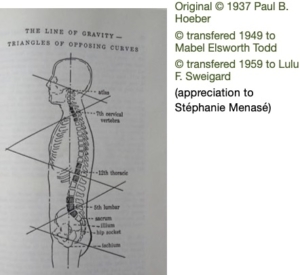

Slides with appreciation to JanWinall.com
FSPM Two Body Processes Interception & Neuroception ©2022 JanWinhall.com
5 Lessons of PolyVagal Theory ©2022 JanWinhall.com
The Intervening Variable ©2022 JanWinhall.com
The Felt Sense PolyVagal Model™ Client Version 6 F’s (3:3) ©2022 JanWinhall.com
The EXP (Experiencing) Scale ©2022 JanWinhall.com
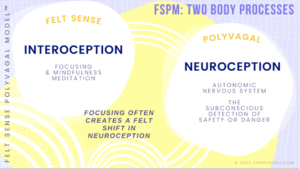
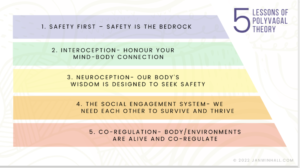

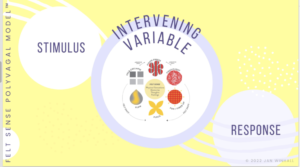
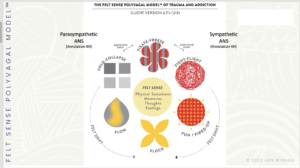
Notes: ‘Polyvagal Theory in Practice’ Canadian Region P2P May 28, 2023
1



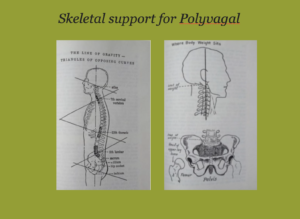
Leave a Reply
Want to join the discussion?Feel free to contribute!